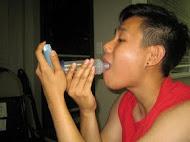There are certain things that can wake us up late at night and these include hunger, bad dreams, thirst and even bathroom runs. But when you wake up late at night with the urge of choking, shortness of breathing, suffocating and running out of breath, it could be a sign of paroxysmal nocturnal dyspnea. Generally, breathing problem is associated with a much more serious and distressing disease – that is, heart problem.
How Does Paroxysmal Nocturnal Dyspnea Occur?

This condition is characterized by shortness of breath accompanied by wheezing and coughing. It usually happens several hours after a person falls into deep sleep in a reclining or semi-reclining position. Paroxysmal nocturnal dsypnea also occurs when a person experiences cold sweats and increased heart rate. It is also known as cardiac asthma, because it mimics some of the symptoms of asthma. However, the difference between the two is that asthma attacks are due to constricted airways resulting from inflammation, while paroxysmal nocturnal dyspnea happens when the air sacs of the lungs are filled with fluid (a condition also known as pulmonary edema). Commonly, a person who experiences paroxysmal nocturnal dyspnea attacks would wake up at night gasping for breath due to feelings of suffocation. Relief from symptoms is felt a few minutes after the attack. Although an episode of paroxysmal nocturnal dyspnea is not fatal, it is life-threatening because it indicates a likelihood of heart problem.
Associated Heart Illnesses
Paroxysmal nocturnal dyspnea is basically one of the many symptoms of left-side heart failure. When a person suffers from left-side heart failure, he/she commonly accumulates more fluid in the lower extremities, because of the inability of the heart to pump blood properly. At night when the person is lying down, the fluid accumulates in the lungs. When air sacs are filled with fluid, the oxygen level falls down, resulting in over-activity of the heart. Because the left side of the heart is unable to match the working capacity of the right side, it results in a pulmonary distress, causing paroxysmal nocturnal dyspnea.
Managing the problem
It is best to lie on bed with an elevated head. Usually a head that is elevated higher than the heart level can help relieve symptoms of shortness of breath. Low sodium, low salt diet also helps avoid fluid retention in the body. When there is low fluid retention, the likelihood of accumulating more fluid in the lungs is also decreased. Still, it is important to see a doctor to determine the underlying cause of your paroxysmal nocturnal dyspnea, as well as to provide the necessary medications and supplementary oxygen needed.
Learn more about circulatory problems
If you want to learn more on how to manage and recognize circulatory problems like paroxysmal nocturnal dyspnea, you can enroll in a CPR and/or first aid course with a credible emergency/ first aid provider near your area. Check out our locations page for more information.
Related Video On Paroxysmal Nocturnal Dyspnea
Sources:
Dyspnea, Orthopnea, and Paroxysmal Nocturnal Dyspnea. (2013). NCBI. Retrieved online on May 20, 2013 from http://www.ncbi.nlm.nih.gov/books/NBK213/ Paroxysmal Nocturnal Dyspnea. (2012). Netdoctor. Retrieved online on May 20, 2013 from http://www.netdoctor.co.uk/ate/seniorshealth/201395.html
